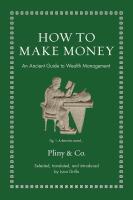
Princeton (2024) h/b 228 pp £15 (ISBN 9780691239125)
This book is the latest in Princeton’s ‘Ancient Wisdom for Modern Readers’ series and as usual presents a selection of passages relevant to the topic in the original text (in this case mainly Latin), with translations, an introduction, commentaries, and a glossary provided by G., Professor of Classics at the University of Notre Dame, Indiana (his previous books have concentrated on Julius Caesar and Cicero). The topic on this occasion is about how the ancient world (particularly the Romans) dealt with personal wealth.
There were three ways in which important Roman individuals could overtly acquire serious wealth: owning agricultural land and selling its surplus produce, which, if successful, would also increase the asset value of the estate; exploiting the taxation system; and lending money at interest. Lower down the food chain, particularly in urban areas, individuals, including slaves, could earn significant cash from providing services—medical, legal, clerical, prostitution, for example. In between sat the traders, often operating in groups, typified by the Phoenicians and the Carthaginians, making their money from transaction margins in any tradable product, including slaves. Like the Victorian aristocracy, Roman senators affected to despise ‘trade’, although they frequently profited from it by the back door via agents (like slaves) or though marriage or, more frequently, adoption. They tended to spend their wealth either on conspicuous domestic building or on public amenities like baths or games.
Most of these elements are evidenced in the selection of texts made by G.— 30 substantial extracts (only two of which are in Greek [Plutarch]) and 6 short epigraphical examples. These are divided into six sections, three about making money, two about spending or losing money and a final section on life as a slave. Most of the authors selected are the usual suspects—Cato, Cicero and the Plinys account for 13 extracts.
Relatively little emerges as to how in detail the Romans made or spent their money. In relation to agricultural estates Cato lists the order of profitability— vineyards first, then, in decreasing importance, garden produce, olives, grazing, grain and various trees. He also advises on the expenses of an estate worked by slaves—you could reasonably budget for each slave 10 amphora of wine and 2 gallons of salt per year and 1 pint of oil per month. They should each be given one tunic set and one pair of clogs per year. As today, good wine that ages well could fetch high prices—the elder Pliny quotes 100 sesterces for the base cost of a standard amphora but gives an example of a sale at 1000 sesterces a jug. The younger Pliny claims to be asset rich and cash poor but can always borrow from his mother-in-law. Plutarch says that Crassus obtained much of his wealth from owning silver mines.
The trading classes are evidenced by some detailed descriptions of where the legal risk lay between shipper and investor in the event of disasters and Trimalchio claims that he made 10 million sesterces in a single trip. One instructive selection is an inscription for a contract to construct a wall with a doorway in Puteoli with very detailed specifications (half the price due on signing the contract and the remainder on its successful completion). Ways to profit from taxation are explained by Cicero (in the Verres speeches) and the younger Pliny is suitably pompous about why foreigners should recognise the benefits they gain from a tax regime.
The epigraphical selections mainly show that slaves could earn enough money to erect inscriptions, and the selected inscription on sumptuary restrictions on financing public games reveals that the money prizes awarded to slave gladiators were only 20% less than those awarded to their free colleagues.
G. has provided workmanlike translations, although in fairness many of the originals are themselves not cast in deathless prose. His commentaries carry the reader further into the subject under review than the extracts themselves but there is no bibliography to encourage further study—only a Glossary which briefly identifies names or subjects referred to in the text.
This volume contains much of interest but the modern-sounding ‘wealth management’ raises expectations that are not quite fulfilled.
Roger Barnes
